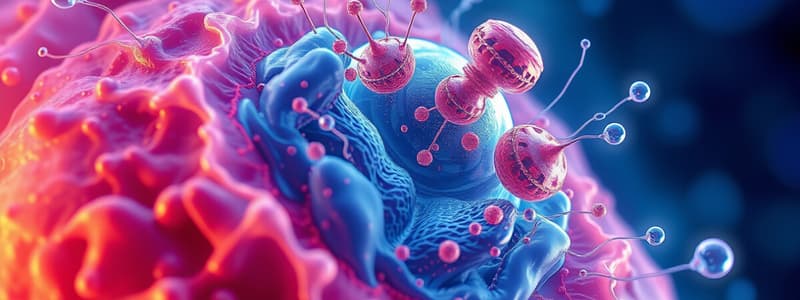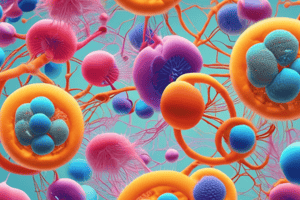Podcast
Questions and Answers
What is the primary process through which all cells originate?
What is the primary process through which all cells originate?
- Cell division (correct)
- Cell differentiation
- Cell fusion
- Cell synthesis
What happens to cells after they reach their maximum size?
What happens to cells after they reach their maximum size?
- They begin to degrade
- They undergo hypertrophy
- They undergo apoptosis
- They divide into two new cells (correct)
How do prokaryotic cells primarily divide?
How do prokaryotic cells primarily divide?
- Meiosis
- Budding
- Binary fission (correct)
- Mitosis
What is one major difference between prokaryotic and eukaryotic cells regarding cell division?
What is one major difference between prokaryotic and eukaryotic cells regarding cell division?
Which step is NOT part of binary fission in prokaryotic cells?
Which step is NOT part of binary fission in prokaryotic cells?
During cell division, what does a chromosome consist of?
During cell division, what does a chromosome consist of?
What does the term 'daughter cells' refer to?
What does the term 'daughter cells' refer to?
Why is cell division generally simpler in prokaryotes compared to eukaryotes?
Why is cell division generally simpler in prokaryotes compared to eukaryotes?
What is the first step in the binary fission process?
What is the first step in the binary fission process?
What is a characteristic feature of eukaryotic cells during cell division?
What is a characteristic feature of eukaryotic cells during cell division?
What is the purpose of DNA replication before cell division?
What is the purpose of DNA replication before cell division?
During which phase does chromosome segregation occur?
During which phase does chromosome segregation occur?
What is the diploid number of chromosomes in humans?
What is the diploid number of chromosomes in humans?
What forms around the two daughter cells during cell division?
What forms around the two daughter cells during cell division?
What is the process called that divides the cytoplasm in eukaryotic cells?
What is the process called that divides the cytoplasm in eukaryotic cells?
Which of the following is true about cytokinesis?
Which of the following is true about cytokinesis?
What is formed once the chromosomes are separated during mitosis?
What is formed once the chromosomes are separated during mitosis?
What occurs to the nuclear membrane during mitosis?
What occurs to the nuclear membrane during mitosis?
How many sets of chromosomes does each daughter cell receive after mitosis?
How many sets of chromosomes does each daughter cell receive after mitosis?
What must occur to all the DNA in a eukaryotic cell prior to cell division?
What must occur to all the DNA in a eukaryotic cell prior to cell division?
Cell division in eukaryotes involves only a single step known as mitosis.
Cell division in eukaryotes involves only a single step known as mitosis.
During DNA replication, a eukaryotic cell produces two identical chromosomes from one chromosome.
During DNA replication, a eukaryotic cell produces two identical chromosomes from one chromosome.
Cytokinesis is the step in cell division where the chromosome number is halved.
Cytokinesis is the step in cell division where the chromosome number is halved.
In humans, mitosis ensures that each daughter cell receives 46 chromosomes.
In humans, mitosis ensures that each daughter cell receives 46 chromosomes.
The nuclear membrane reforms during the process of cytokinesis.
The nuclear membrane reforms during the process of cytokinesis.
All cells originate from preexisting cells through the process of cell division.
All cells originate from preexisting cells through the process of cell division.
Eukaryotic cells have a single circular chromosome.
Eukaryotic cells have a single circular chromosome.
Binary fission is exclusively used by eukaryotic cells for division.
Binary fission is exclusively used by eukaryotic cells for division.
In prokaryotic cell division, DNA replication is one of the initial steps.
In prokaryotic cell division, DNA replication is one of the initial steps.
The daughter cells formed from binary fission are larger than the parent cell.
The daughter cells formed from binary fission are larger than the parent cell.
Match the type of cell with its characteristic:
Match the type of cell with its characteristic:
Match the steps of binary fission with their descriptions:
Match the steps of binary fission with their descriptions:
Match the cell division processes with their descriptions:
Match the cell division processes with their descriptions:
Match the components with their roles in cell division:
Match the components with their roles in cell division:
Match the statements about cell division to their correct outcomes:
Match the statements about cell division to their correct outcomes:
Match the steps of cell division in eukaryotes with their descriptions:
Match the steps of cell division in eukaryotes with their descriptions:
Match the key terms related to eukaryotic cell division with their definitions:
Match the key terms related to eukaryotic cell division with their definitions:
Match the phase of mitosis with its main event:
Match the phase of mitosis with its main event:
Match the following components involved in eukaryotic cell division with their roles:
Match the following components involved in eukaryotic cell division with their roles:
Match the following statements about eukaryotic cell division with their truths:
Match the following statements about eukaryotic cell division with their truths:
Flashcards are hidden until you start studying
Study Notes
Origin of Cells
- All cells originate from preexisting cells through cell division.
- Cells can be simple, like bacteria, or complex, such as muscle or blood cells.
- An organism begins as a single cell, which divides to form many cells.
Cell Division Process
- Cell division is how a parent cell divides to produce two daughter cells.
- This process consists of a continuous cycle of growth, division, and replication.
- Prokaryotic cell division is simpler than eukaryotic due to fewer components.
Prokaryotic Cell Division
- Prokaryotic cells primarily divide through binary fission.
- Key steps in binary fission:
- DNA Replication: The cell copies its DNA to form two identical chromosomes.
- Chromosome Segregation: The chromosomes separate and move to opposite ends of the cell, attaching to the cell membrane.
- Separation: A new plasma membrane grows inward, and the cytoplasm divides, forming two genetically identical daughter cells.
Eukaryotic Cell Division
- Eukaryotic cell division is more complex, involving multiple chromosomes and organelles.
- Occurs in two main stages:
- Mitosis: A multi-phase process where the nucleus divides, and chromosomes are sorted to ensure each daughter cell has the correct number of chromosomes (46 in humans).
- Cytokinesis: Division of the cytoplasm, resulting in two genetically identical daughter cells.
Key Concepts
- Chromosomes are coiled structures made of DNA and protein.
- Prokaryotic cells typically have a single circular chromosome, while eukaryotic cells have multiple linear chromosomes housed within a nucleus.
- Mitosis and cytokinesis are critical for the proper replication and distribution of genetic material during eukaryotic cell division.
Origin of Cells
- All cells originate from preexisting cells through cell division.
- Cells can be simple, like bacteria, or complex, such as muscle or blood cells.
- An organism begins as a single cell, which divides to form many cells.
Cell Division Process
- Cell division is how a parent cell divides to produce two daughter cells.
- This process consists of a continuous cycle of growth, division, and replication.
- Prokaryotic cell division is simpler than eukaryotic due to fewer components.
Prokaryotic Cell Division
- Prokaryotic cells primarily divide through binary fission.
- Key steps in binary fission:
- DNA Replication: The cell copies its DNA to form two identical chromosomes.
- Chromosome Segregation: The chromosomes separate and move to opposite ends of the cell, attaching to the cell membrane.
- Separation: A new plasma membrane grows inward, and the cytoplasm divides, forming two genetically identical daughter cells.
Eukaryotic Cell Division
- Eukaryotic cell division is more complex, involving multiple chromosomes and organelles.
- Occurs in two main stages:
- Mitosis: A multi-phase process where the nucleus divides, and chromosomes are sorted to ensure each daughter cell has the correct number of chromosomes (46 in humans).
- Cytokinesis: Division of the cytoplasm, resulting in two genetically identical daughter cells.
Key Concepts
- Chromosomes are coiled structures made of DNA and protein.
- Prokaryotic cells typically have a single circular chromosome, while eukaryotic cells have multiple linear chromosomes housed within a nucleus.
- Mitosis and cytokinesis are critical for the proper replication and distribution of genetic material during eukaryotic cell division.
Origin of Cells
- All cells originate from preexisting cells through cell division.
- Cells can be simple, like bacteria, or complex, such as muscle or blood cells.
- An organism begins as a single cell, which divides to form many cells.
Cell Division Process
- Cell division is how a parent cell divides to produce two daughter cells.
- This process consists of a continuous cycle of growth, division, and replication.
- Prokaryotic cell division is simpler than eukaryotic due to fewer components.
Prokaryotic Cell Division
- Prokaryotic cells primarily divide through binary fission.
- Key steps in binary fission:
- DNA Replication: The cell copies its DNA to form two identical chromosomes.
- Chromosome Segregation: The chromosomes separate and move to opposite ends of the cell, attaching to the cell membrane.
- Separation: A new plasma membrane grows inward, and the cytoplasm divides, forming two genetically identical daughter cells.
Eukaryotic Cell Division
- Eukaryotic cell division is more complex, involving multiple chromosomes and organelles.
- Occurs in two main stages:
- Mitosis: A multi-phase process where the nucleus divides, and chromosomes are sorted to ensure each daughter cell has the correct number of chromosomes (46 in humans).
- Cytokinesis: Division of the cytoplasm, resulting in two genetically identical daughter cells.
Key Concepts
- Chromosomes are coiled structures made of DNA and protein.
- Prokaryotic cells typically have a single circular chromosome, while eukaryotic cells have multiple linear chromosomes housed within a nucleus.
- Mitosis and cytokinesis are critical for the proper replication and distribution of genetic material during eukaryotic cell division.
Studying That Suits You
Use AI to generate personalized quizzes and flashcards to suit your learning preferences.



